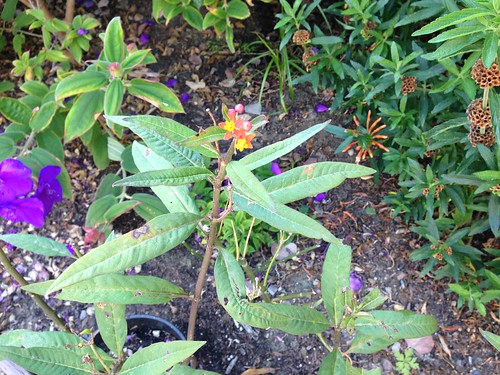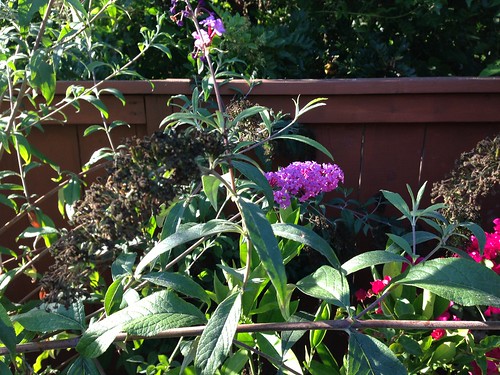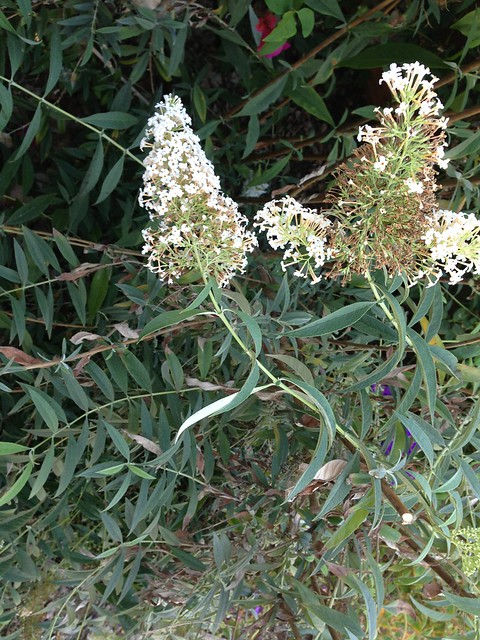The following post was written by my mom, WWW. Thanks, mom!
Last night, my writing group came to dinner, an amazing
group of women who I have been writing with for years. We were enjoying our mock tuna stuffed tomatoes outside on the patio, loving the plethora of butterflies floating around us,
when suddenly someone noticed a lot of flapping on a beanstalk. “Looks like the butterflies are having some
fun in your vegetable patch,” one friend exclaimed. And sure enough…right in front of us were two monarchs mating. None of us had ever seen butterfly sex before, and let me tell you, it was
quite something.
I have always had lots of butterflies in my garden, but this
year, they are everywhere—mourning cloaks, swallow tails, sulfurs,
and lots and lots of monarchs. One reason is that I planted two
butterfly bushes (Buddleias) last year and they are living up to their reputation
as butterfly magnets. But when Larry found a monarch caterpillar on our pool
fence on Saturday, I was perplexed. Monarch
butterflies obviously are happily drinking nectar from my Buddleias, but the
larvae only eat milkweed, and I have never planted any in my garden. Archer and Fable fell in love immediately
with the beautiful striped caterpillar and set out to find food for him. Like good scientists, we brought in all sorts
of leaves from plants near the fence, but the caterpillar turned his nose up on
all samples…we even tried kale, spinach, and arugula from the refrigerator, but
to no avail.
“He must be eating something. He’s nice and fat,” I insisted
and I returned to the garden, determined to find the source of his meals. And that’s when I found a bunch of naked
stems sticking up from the ground, denuded of their leaves, and two more
monarch larvae munching on the rapidly shrinking sticks. I remembered noticing this volunteer plant a
couple of weeks back, wondering if it was a weed. At that time it had lots of leaves and also
pretty orange blossoms and I had decided not to pull it out.
Now it was
completely stripped of anything green or orange.
“AHH!! It must be milkweed!” I exclaimed
“But Gooey,” Archer implored, “There’s nothing left for them
to eat!! What will they DO?”
I immediately called Armstrong’s Gardens to see if they had any milkweed plants and luckily they had two, although they were in pretty poor shape. We bought them anyway so our four caterpillars would have enough food to hopefully pupate. Unfortunately, I checked on them today and couldn’t find a caterpillar.
Birds hate to eat monarchs (they make them sick), so hopefully our friends have gone somewhere to quietly form their chrysalises. Meanwhile, I’m going to plant my two milkweed plants and by next spring, they will hopefully be big enough to sustain lots of monarch caterpillars for our grandchildren’s delight.
I immediately called Armstrong’s Gardens to see if they had any milkweed plants and luckily they had two, although they were in pretty poor shape. We bought them anyway so our four caterpillars would have enough food to hopefully pupate. Unfortunately, I checked on them today and couldn’t find a caterpillar.
Birds hate to eat monarchs (they make them sick), so hopefully our friends have gone somewhere to quietly form their chrysalises. Meanwhile, I’m going to plant my two milkweed plants and by next spring, they will hopefully be big enough to sustain lots of monarch caterpillars for our grandchildren’s delight.
Creating a backyard habitat for butterflies and birds is
fun for the whole family. Buddleias and
milkweed are easy to grow and will bring hours of delight for kids. We don’t use any pesticides whatsoever in our
yard, so birds love hanging out there - oodles of caterpillars for them
to eat. I provide my birds, bees, and
butterflies with water in the form of a birdbath, and I have some birdhouses in
the trees. Birds especially love fountains so putting one in the garden will
delight your feathered friends. Bird feeders will attract seed eating birds,
but I don’t have any bird feeders and I still have tons of birds. This year, I
haven’t found one tomato hornworm on my tomatoes but often see a mockingbird or
oriole with one hanging from their beak. One of the great rewards of gardening
naturally is that you establish a habitat where birds and butterflies have
plenty to eat. I love watching the balance of nature at work in my own backyard.
Besides Buddleias, there are many other plants that attract
butterflies. If you want to make a
butterfly garden, here are a few easy steps:
1.
DON’T use any chemical sprays in your garden.
2.
Plant some host plants such as milkweed for
monarchs and parsley and dill for swallowtails. (This is not necessary to have
butterflies in your garden, but it’s fun for the kids to watch the full cycle).
3.
Plant flowers that contain nectar such as
buddleia, asters, zinnias, alum, lilacs, salvia, verbena, and lantana. (Go here
for a more complete list.)
4.
Sit in your garden and enjoy watching the
beautiful butterflies.
Enjoy!
Love,
WWW
P.S. This is a note from Nana: It's of interest also to note, that the Spotted Cabbage White butterfly that begins to proliferate in fall with cooler weather, does a great deal of damage to winter crops, especially members of the cabbage family. The most beautiful butterflies—Monarch, Gulf Fritilary, Swallowtail, Morning Cloak and others do very little damage. Alternatively, stick to one or two plants that gardeners are content to sacrifice in return for the loveliness of the butterflies. I think of them as the floating flowers of the garden and called them that in my Southwest book. Morning Cloak is one of my favorites since they are friendly and will come and sit on my outstretched palm.
IMPORTANT NOTE: Buddleias are invasive in many parts of the country. Before planting a buddleia, check with your local cooperative extension or farm advisor to see if you can grow it where you live or make sure you buy sterile hybrids... they do not make seeds.
IMPORTANT NOTE: Buddleias are invasive in many parts of the country. Before planting a buddleia, check with your local cooperative extension or farm advisor to see if you can grow it where you live or make sure you buy sterile hybrids... they do not make seeds.







0 comments:
Post a Comment